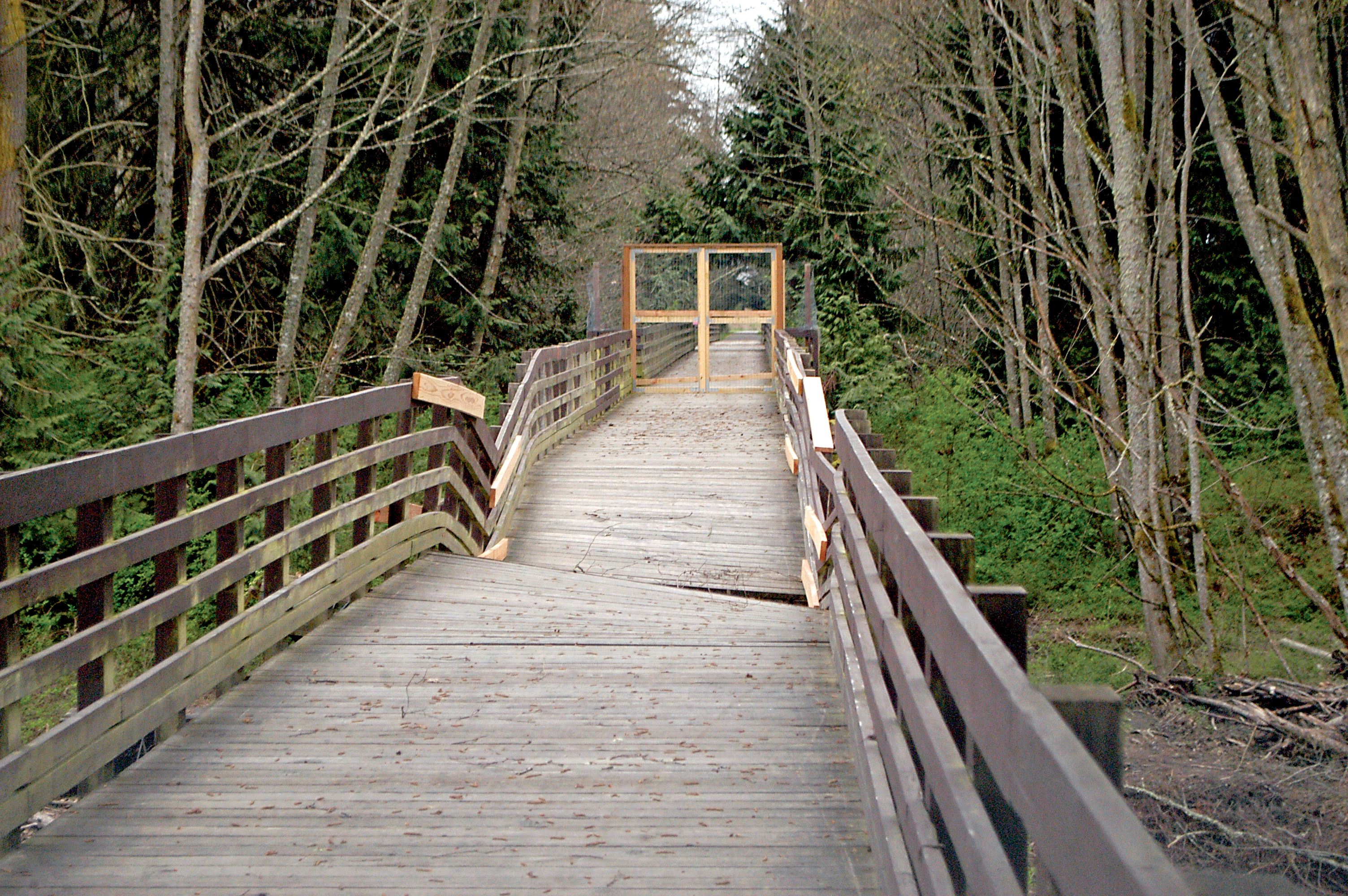SEQUIM — An early estimate of the cost of repair or replacement of Railroad Bridge is $1.8 million, according to the Jamestown S’Klallam tribe, which is seeking funding to repair February flood damage that prompted closure of the bridge to through traffic.
And although the tribe hopes to find a stopgap measure to allow the bridge to be reopened this summer, it may not be in time for the North Olympic Discovery Marathon on June 7, a race that draws thousands of runners annually.
So a new route has been mapped out for the race, Larry Little, president of the marathon, said Friday.
According to the plan, runners this year would start in Agnew and would not run through Sequim as they have done in the past.
The rain-swollen Dungeness River tore away pilings and a truss section of the trestle on the west side of the bridge Feb. 6.
The bridge itself is undamaged, but traffic over it has been closed because the trestle is unsafe.
The Jamestown S’Klallam tribe, which owns the 99-year-old bridge, is in the process of gathering funding to repair or replace the trestle, Annette Nesse, chief operating officer, said last week.
A “very early conceptual cost” estimate for fixing the trestle is $1.8 million, Nesse said.
“For the short term, we are looking to maybe use some of the tribe’s insurance money,” she said.
Federal highways funds also may be available, she said.
As far as reopening the trestle, the tribe is “exploring any and all options, and so we continue to look at what we might build in the short term to get the bridge open to traffic as soon as possible,” Nesse said.
“We don’t have a firm date for that, but we definitely haven’t ruled out that we would like to get the bridge open this summer,” she added.
Until the closure, Railroad Bridge was a well-traveled passage of the Olympic Discovery Trail, a hiking-cycling-equestrian path that runs through parts of Jefferson and Clallam counties.
Since 2003, it has been part of the route of the marathon.
“As soon as we found out the bridge was down and we couldn’t be assured that it was going to be open in time for the race, we went ahead and started making contingency plans,” Little said.
The plans are to start the marathon in Agnew, west of Sequim, instead of in Blyn, east of Sequim.
Runners would head east to the Dungeness River Bridge before doubling back to the starting point. From there, the route will be unchanged from other years, ending at City Pier in Port Angeles.
Little said the marathon board is in the process of finalizing the route with Clallam County officials.
When the final agreement is concluded, a map of the route will be posted online at www.nodm.com.
The new course would “be safe” and “very scenic,” Little said.
“It will still have the quality of aid stations and support that it has always had.
“The bad thing is we don’t get to start at [Blyn], which is an awesome venue, and we don’t get to go through Sequim, which we really like to show off.”
The tribe is continuing to look at funding to design a new, improved trestle that is better able to withstand floodwaters, Nesse said.
“Right now, the structure is built on a wood-pile infrastructure at 16-foot spans, and that is a design that was pretty common back in the early 1900s when the trestle was built,” Nesse said.
“We would like to see those intervals between the infrastructure supports extended so that they don’t catch debris from the river quite so easily, allowing the river to flow under the trestle structure unimpeded.”
The bridge itself would not be affected by the renovations.
“The structure that was damaged in February was the trestle, and that is the structure from the west end of the bridge west to the Runnion Road side of the park,” she said.
“The bridge is on the National Historic Register. It is a historic bridge . . . and we want to see it remain intact in its original design.”
The bridge was constructed of wood by the Seattle, Port Angeles and Western Railway — a subsidiary of the Chicago, Milwaukee, St. Paul and Pacific Railroad — in 1916.
The original structure was replaced in 1930 by a steel Howe truss 156 feet long and 22 feet high.
The tribe will most likely keep the theme of the original bridge when constructing a new trestle, Nesse said.
“I am sure there is something we can do in the design phase to make it complement the bridge.”
Nesse noted that “one of the common misconceptions is that it is a public park and that it is paid for by tax dollars.
“But it is not. It is tribal property,” she said. The general public is “not paying for it with their tax dollars.”
Nesse said the tribe will fix the trestle as soon as it can.
“We recognize that it is the only pedestrian Dungeness River crossing on the Olympic Discovery Trail,” she said.
“Some of the data we have collected over the years indicates that we have 100,000-plus crossings per year over that bridge, so the tribe is aware it is important, it is popular and the public uses it all time.
“We are trying to do all that we can to get it back up and available to the public.”
________
Sequim-Dungeness Valley Editor Chris McDaniel can be reached at 360-681-2390, ext. 5052, or at cmcdaniel@peninsuladailynews.com.
